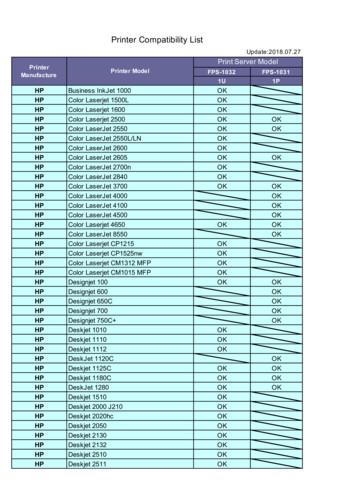Tech Bulletin Brick Color Correction JUL20
ENGINEERINGSERVICESBrick staining or brick color correction is a widely accepted industry standard practice for dealing withbrick color issues. The process has been time tested to be durable and color fast. Brick colorcorrection methods are utilized by virtually every brick manufacturer in the United States. There arealso brick color correction contractors that specialize in this process.There are a variety of proven application methods including Sodium Silicate, Potassium Silicate, andAcrylic bases. Inorganic color fast pigments are used in all of these bases, and typical stainformulations normally utilize the same materials that were used to manufacture the brick.The process used on the job is custom tailored on each project and the stains are custom mixed onsite to match the required color range. The stains are not applied in mass rather the stains are appliedindividually to the brick units that require treatment. Stain application may consist of several differentcolors applied to each brick. Typically a test/ approval area will be set up for customer review andapproval before staining commences on the buildingWhen the process is completed the customer will receive a warranty for the durability andperformance of the process. Please find attached some additional information regarding the stainingprocess.Attachments: Endorsement letter from BIA Endorsement from Southern Brick Institute Article from Masonry Construction MagazineTech Bulletin Brick Fire Ratings6.19.20 1 P a g eThe information contained herein is believed to be reliable, but no representations, guarantees or warranties of any kind are made as to its accuracy, suitability for particular applications or the resultsto be obtained. Because of the variations in methods, conditions and equipment used in various forms of masonry installing, cleaning, and / or repairing, no warranties or guarantees are made as tothe suitability of the products for the applications disclosed. GENERAL SHALE BRICK, INC. shall not be liable for and the customer assumes all risk and liability for any use or handling of any materialbeyond GENERAL SHALE BRICK, INC. direct control. The SELLER MAKES NO WARRANTIES, EXPRESS OR IMPLIED, INCLUDING, BUT NOT LIMITED TO, THE IMPLIED WARRANTIES OF MERCHANTABILITYAND FITNESS FOR A PARTICULAR PURPOSE. Please consult a building professional before installing, cleaning or repairing any masonry product.General Shale Brick, Inc. / 3015 Bristol Highway, Johnson City, Tennessee 37602 / 800.414.4661 2014 General Shale Brick Inc., All rights reserved. All marks are the property of General Shale Brick,inc. www.generalshale.comwww.GeneralShale.com For more information and expert advice, call General Shale at 1.800.414.4661
July 10, 2020Mr. Jim Bryja, SE, PEGeneral Shale Brick3015 Bristol HighwayJohnson City, TN 37601Sent via email: Jim.Bryja@generalshale.comRe: Staining Brick MasonryMr. Bryja:This letter is in regard to BIA’s policy on staining brick and brick masonry. On occasion, one maydesire to change the color of brick in portions or entire facades of existing or newly constructedbrick masonry. Instead of removing and replacing brick in well-constructed brick masonry whichis acceptable in every other respect, the color of the brick is typically changed through stainingthe exposed surfaces of the brick in the existing or new brick masonry.Staining brick masonry is a widely-accepted industry practice that has been successfully executedon brickwork to correct brick color issues or problems since at least 1960. The process involvesthe application of certain ceramic stains and pigments specifically blended for the brick of theproject. Trained, experienced professionals under the employ of reputable, responsible brickmanufacturers or specialized brick staining contractors apply the staining materials in accordancewith the material manufacturer’s directions. The stain then permeates the porous surface of thebrick resulting in a color-fast, durable finish that can perform in climatic conditions throughoutNorth America including hot, humid, high precipitation and freezing weather. Properly appliedbrick stains have proven to be durable over time. In fact, most stain manufacturers provide awarranty for their product.Brick staining invariably avoids many of the physically and economically impractical situationsthat arise from removing and replacing existing or new brick. Such situations include thescheduling, time, expense and mess associated with demolition and construction. The staining ofindividual brick allows the existing mortar to remain in place and avoids the possibility ofmismatching the color of fresh mortar with the existing mortar color. In fact, some architectshave used brick staining on some new projects to provide an exact color for the brickwork theydesire.Staining brick masonry is a viable method for changing the color of existing and new brick andmortar surfaces. Furthermore, brick staining does not affect the structural integrity of the brickunits or the mortar joints. In short, staining brick masonry is a widely accepted practice thatproduces a color-fast, durable finish that delivers successful, proven performance.If you have any further questions, please do not hesitate to contact me.Cordially,Charles B. Clark, Jr., AIA, PE, LEED APVice President, Engineering Services1850 Centennial Park Drive, Suite 301, Reston, VA 20191-1542 Phone: 703-620-0010 Fax: 703-620-3928 www.gobrick.com
Color Correction Of BrickworkThere are a number of circumstances that call for finished brickwork to be color corrected. These may include,among others, buildings where brick from different production runs must be used; where multiple colors ofbrick in a job may not have been properly distributed, causing a patchwork appearance; where the faces of brickhave been damaged by rough handling or by improper cleaning methods; or where an addition to a buildingrequires that newly manufactured brick must be laid next to existing brickwork.In many of these cases it is not physically or economically practical to remove and replace brick to correct theabove mentioned color inconsistencies. A patched section in brickwork is often more visually offensive thanthe original condition due to variations in mortar set rate, mortar color matching and brick run matching issues.Brick colors, textures and finishes are intentionally varied by manufacturers to give the customer nearly infinitechoices of brick blends. The variations are accomplished by changing brick clay mixes, by surface treatmentwith unique mechanical texturing devices, by surface additions of numerous sand, mineral or slurry coatings,and by changes in firing techniques. Some of these coloring techniques are virtually indestructible. Some aredesigned to change over time. Some are vulnerable to damage by improper handling and cleaning. All arecapable of being laid in the wall in less than desirable blends. Brick manufactures’ package tags usually givedetailed instruction on color blending, sampling of material before installation and proper cleaning methods.Despite the best efforts to avoid color inconsistencies in brickwork, they still occur. The color correction ofbrick masonry by application of ceramic stains and pigments is a widely used and accepted practice in brickconstruction. Brick colors are corrected on the surface in the wall more often than may be realized.Color correction of brick masonry has been successfully done since at least 1960. The materials and methodsemployed by responsible brick companies and staining contractors have been developed and perfected to thepoint that corrected areas are virtually invisible. When a repair is made and the repaired section isundistinguishable from the remainder of the brickwork for the life of the building, it is regarded as a successfulrepair.Many owners and general contractors who have never heard of color correction of brickwork are at firstsurprised and skeptical, because it is a new process to them. This is understandable, but it should beremembered that brick manufacturers and distributors have a vested interest in providing an attractive,functional product to the construction industry. If a responsible manufacturer recommends color correction ofbrickwork as a solution to an aesthetic problem, they have experience and confidence in this useful, althoughoften unknown procedure.1810 Overlake Drive - Suite A · Conyers, GA 30013 · 770-760-0728 · Fax: 770-760-7810www.sbionline.orgStaining Package.doc06/13/16
Changing the faceof masonryHand-applied color treatment corrects problems, enhances details,and allows closer color matching in rehab workBy Kenneth A. Hookert happens in new construction:Block from different production runs are mixed in a wall;range brick are unevenly distributed; mortar color is inconsistent.It happens in remodeling andrestoration: New brick, howevercarefully selected, just don’tmatch the original material.The building owner is unhappy. The architect won’t approvethe job. The contractor’s payment is withheld. And the material supplier and manufacturer areon the spot.Tearing down the wall andstarting over is a drastic solutionto a color problem, but it hasbeen done. Materials manufacturers can correct some color problems in the field, but the possibilities and results have beensomewhat limited.IColoring service foundedAfter 1 day of work, colors are blended to the satisfaction of the owner andbuilder. The color-treated brick are virtually indistinguishable from untreated brick and are guaranteed for 25 years.One person who spent 18 yearswith a Canadian manufacturerspecializing in such correctivework developed and refined thesecolor alteration materials andtechniques to an unusual degree.His success in coloring masonryled him to found his own servicecompany. Founded in Toronto in1988, the firm now has six officesacross Canada and has recentlyopened U.S. operations nearChicago and Atlanta.The company’s clients weredrawn first from manufacturersand distributors of materials, eager to correct color problems andsettle disputes. As its business
became more established, however, the company began cateringto building owners and architectsas well.Working with proprietary, water-based, multipolymer stains,the company’s “masonry artists”use a variety of hand-applicationtechniques to change the appearance of masonry in place. The pigments are absorbed into the poresof the masonry units or mortar tomake a color change that lasts indefinitely but can be altered byfurther application of stain.Case historyOn one recent residential job,the brick was to have an overallred base with range brick ofwhite, grayish-tan, and black. Thebrick was delivered and laid; however, it lacked enough of therange colors, so many areas werealmost completely red.The coloring crew mixed quan-tities of the three range colorsand set to work. After experimenting to find the correct colors andapplication techniques, theystained selected brick to matchthe desired color range and distribution. The work was completedin 1 day at a cost of about 800.According to a company representative, their work generallycosts about 11 0 the cost of replacing masonry in a wall.Porosity and textureare importantThe process is said not to belimited by the degree of colorchange needed. Masonry can bestained from light to dark, dark tolight, or to a different hue of thesame value.Limitations do exist, however,based on the porosity and densityof the masonry. Very hard,smooth brick do not accept thecolor as well as more porous ma-Too few range brick were delivered and installed, resulting in an uneven and unacceptable appearance.terials. The work also is limitedby variations in texture. Bark- orother rough-textured brick cannotbe made to appear the same as asmoother material, even if theircolors are identical.Company vice president PeterWoodworth says the companymaintains 100% customer satisfaction by making clear toprospective customers what results they can expect. “Once wefeel the customer has a realisticview of what we can achieve, wedo whatever it takes to make thathappen,” says Woodworth.“Sometimes it’s more work thanwe initially expect, sometimes it’sless. As our crews gain experience, though, they become moreaware of what they can do andhow to do it efficiently.”Two-person crews travel invans equipped with about adozen common colors premixed,plus bases and pigments to mix“Masonry artists” apply water-based, multipolymerstain and create the desired color blend.
unusual shades. They carrybrushes, sponges, rags, and otherimplements to apply the color.“Though we learned the name‘masonry art’ was too generic toqualify for trademark designation,we think it’s a good description ofthe work we do,” says Woodworth. “Our technicians need agood eye for color and texture,and a knowledge of applicationtechniques.”Corrective workOn one job, the companychanged the mortar color on abuilding in which colored mortarwas intended but inadvertentlyomitted from the specifications.Its crew has matched the colorsof interior walls constructed of 8and 12-inch architectural blockfrom two different productionruns. They’ve recolored whiteconcrete block smoke-stainedfrom a fire adjacent to the storageyard to match undamaged blockinstalled in the same wall.Other work has not been cor-rective, but merely cosmetic. Ahomeowner wishes to highlightdecorative brickwork—quoins,arches, dentils, and so on—bymaking it a different color fromthe rest of the house. Or tochange the color of a fireplace tobetter complement a remodeledliving room.Restoration projectsOne major field of work is inrestoration and remodeling. Forinstance, an addition is removedand portions of an original wallneed to be rebuilt. The originalbrick is no longer available. Mostof the time, the impulse is to trymatching the color as closely aspossible with new brick. Woodworth says his company can workwith the restoration architect toachieve a better match.“We tell them to look for newbrick that matches the size andtexture of the original, in a shadea little bit lighter. We can then goin and easily alter the color for anexact match.”In interviews, customers, including building owners, contractors, manufacturers, and architects, were uniformly enthusiasticabout the results achieved. Allagreed that the appearance of thecolor-treated material was excellent, and none was reluctant touse the service again.The one concern expressedwas how long the color wouldlast and whether color- t re a t e dmaterial would react diff e re n t l yto weather exposure from untreated material. The companydoes offer accelerated freezethaw and UV-exposure test results (and many years’ experience with a spirit-based stain)to back its 25-year guarantee.But no projects using its waterbased stains have been finishedlong enough to confirm longterm perf o rm a n c e .PUBLICATION #M910470Copyright 1991The Aberdeen GroupAll rights reserved
The color correction of brick masonry by application of ceramic stains and pigments is a widely used and accepted practice in brick construction. Brick colors are corrected on the surface in the wall more often than may be realized. Color correction of brick masonry has been success
OLD BRICK ORIGINALS THIN BRICK VENEER Page 10 FAST ADHESIVE METHOD Step 1: Install the Cement Fiberboard Secure the fiberboard to your wall studs using 3/4” screws. Be sure to countersink the screws so the brick can bond properly to the board. File Size: 2MBPage Count: 12Explore furtherRecommended Application Guidelines for Adhered Thin Brick .www.interstatebrick.comThin Brick Veneerwww.gobrick.comDesigning & Detailing Adhered Veneer Systems . - BRICK-ITbrickit.comRecommended to you b
3D Color Correction–1st Order Polynomial Regression 3D Color Correction–2nd Order Polynomial Regression 3D Color Correction–Look-up Table 24.7 15.7 15.5 15.0 0.5 18 ΔE* 94is calculated according to calibration ball. 3D Color Correction – LuminanceDistribution Curve pixel 1 pixel n
Thin Brick meet ASTM C1088 standard specification for Thin Veneer Brick Units made from clay or shale. In this specification, the term thin veneer brick shall be understood to mean clay masonry unit with a maximum thickness of 1-3/4". Grade Exterior Belden Brick manufactures thin brick to meet Grade Exterior with a weathering index of SW. Types
the best color correction for elements in your document. You can specify the color correction in a supported driver: Windows 95 / Windows 98 PostScript driver: On the TekColor tab, select the desired color correction. Some of the color corrections are grouped under Office Color and Press Match Color. Windows 2000 / Windows NT PostScript driver:
Birmingham AL Architectural Works, LLP; Derck & Edson Associates, LLP HMF to Brick, Brick to Brick, Brick to Wood, Brick to Soffit, Stone to Stone, Louvers to Brick 890 NST New Margaret Elementary School Odenville AL Lathan Associates Achitects PC 890 NST The University of Alabama at Birmingham New Alumni Building
and many other brick applications. Use our Masonry Designer or Virtual Mason at www.beldenbrick.com to lay out brick patterns, compare colors and even change the mortar on brick walls. Along with our more than 200 distributors across the country plus Belden Brick regional sales managers and customer service personnel, The Belden Brick Com-
FPS-1032 FPS-1031 1U 1P HP Business InkJet 1000 OK HP Color Laserjet 1500L OK HP Color Laserjet 1600 OK HP Color Laserjet 2500 OK OK HP Color LaserJet 2550 OK OK HP Color LaserJet 2550L/LN OK HP Color LaserJet 2600 OK HP Color LaserJet 2605 OK OK HP Color LaserJet 2700n OK HP Color LaserJet 2840 OK HP Color LaserJet 3700 OK OK HP Color LaserJet 4000 OK HP Color LaserJet 4100 OK
the risks of adventure travel. Adventure travel is supposed to be challenging. But regardless of your age, destination or chosen activity, your safety should be of paramount importance. BS 8848 sets standards to minimize the risks of adventure travel. Knowledge of the standard is important to anyone organizing, or taking part in, an overseas venture. 2 Hundreds of thousands of people take part .























